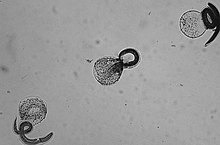Baylisascaris
| Baylisascaris | |
|---|---|
 |
|
| Baylisascaris procyonis larvae | |
| Scientific classification | |
| Kingdom: | Animalia |
| Phylum: | Nematoda |
| Class: | Secernentea |
| Order: | Ascaridida |
| Family: | Ascarididae |
| Genus: | Baylisascaris |
Baylisascaris is a genus of roundworms that infect more than fifty animal species.
Baylisascaris eggs are passed in faeces and become active within a month. They can remain viable in the environment for years, withstanding heat and cold. According to University of California, Davis, and the Santa Barbara County Public Health Department, animals become infested either by:
After an animal swallows the eggs, the microscopic larvae hatch in the intestine and invade the intestinal wall. If they are in their definitive host they develop for several weeks, then enter the intestinal lumen, mature, mate, and produce eggs, which are carried out in the fecal stream. If the larvae are in a paratenic host, they break into the bloodstream and enter various organs, particularly the central nervous system. A great deal of damage occurs wherever the larva try to make a home. In response to the attack, the body attempts to destroy it by walling it off or killing it. The larva moves rapidly to escape, seeking out the liver, eyes, spinal cord or brain. Occasionally they can be found in the heart, lungs, and other organs. Eventually the larva dies and is reabsorbed by the body. In very small species such as mice, it might take only one or two larvae in the brain to be fatal. If the larva does not cause significant damage in vital organs, then the victim will show no signs of disease. On the other hand, if it causes behavioral changes by destroying parts of the brain, the host becomes easier prey, bringing the larva into the intestine of a new host.
While worming can rid the intestine of adult Baylisascaris, no treatment has been shown to alleviate illness caused by migrating larvae. Despite lack of larvicidal effects, albendazole (20–40 mg/kg/d for 1–4 weeks) has been used to treat many cases.
Each Baylisascaris species has a host species that it uses to reproduce. The eggs appear in the host species' feces. They can then be ingested by, and infest, a variety of other animals (including humans) that serve as paratenic hosts.
Baylisascaris species include:
Baylisascaris procyonis, the raccoon parasite, is related to the canine roundworm Toxocara canis. It is found in the intestines of raccoons in North America, Japan and Germany. It infests 68 to 82% of some raccoon populations, according to the House Rabbit Society. This parasite can be extremely harmful or deadly to humans.
...
Wikipedia
